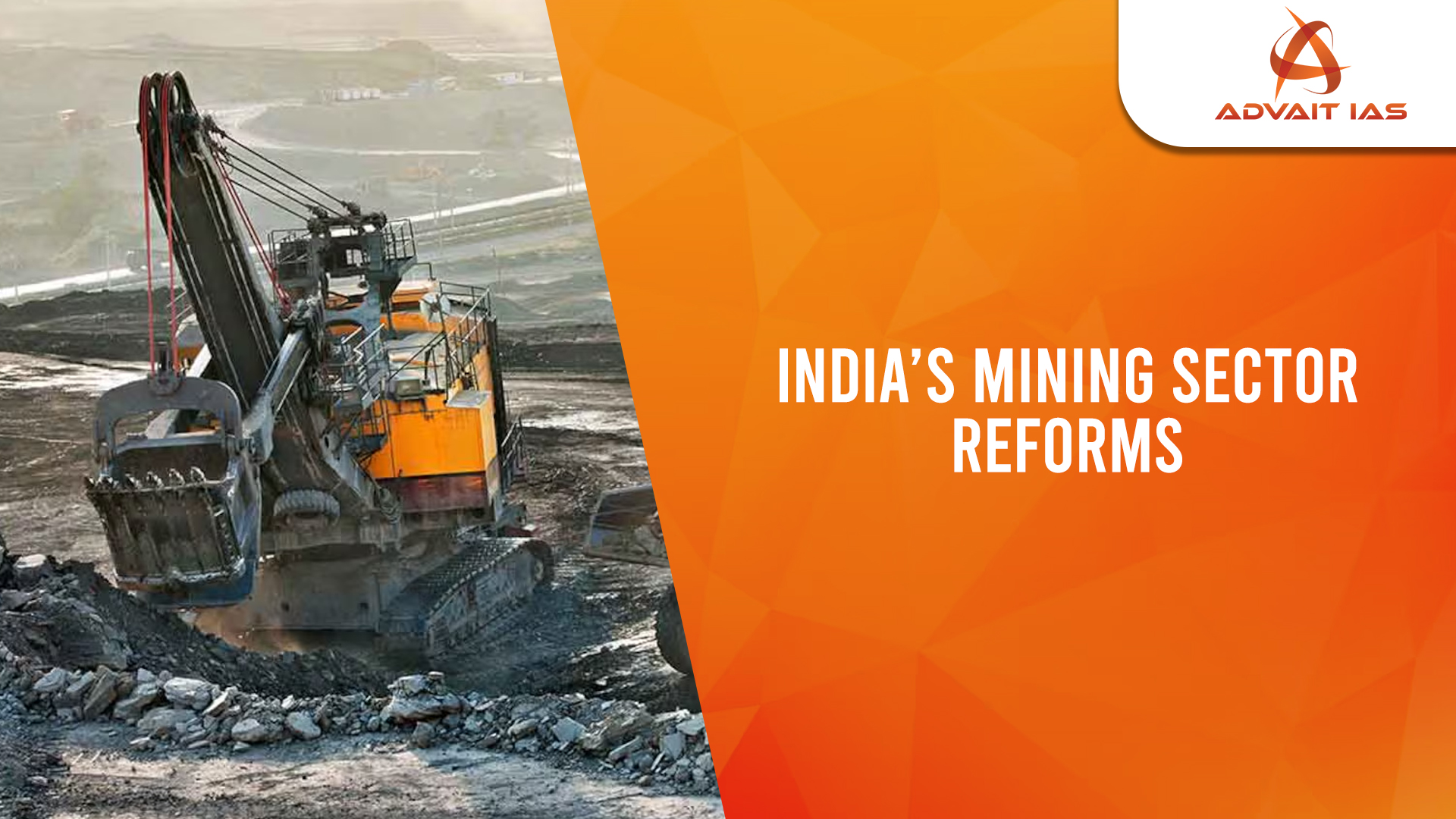Rajasthan holds immense potential for potash mining, with over 95% of the country’s estimated reserves found in the state.
In May 2025, India auctioned its first potash block, marking a significant reform step in boosting mineral self-sufficiency and attracting private investment.
- This milestone aligns with India’s broader push to transform the mining sector into a key pillar of economic growth and resource security.
Key Reforms Transforming India’s Mining Sector:
1. Legal and Structural Reforms:
- MMDR Amendment Act, 2015: Replaced discretionary allotments with transparent auction system, introduced District Mineral Foundation (DMF) for local area development.
- MMDR Amendment, 2021:
- Removed end-use restrictions for coal mining.
- Extended mining leases to 50 years.
- Introduced Composite Exploration-cum-Mining Licences (CEMP).
2. National Mineral Policy (NMP), 2019:
- Emphasizes sustainable and scientific mining.
- Promotes private sector participation, ease of doing business, and adoption of AI, blockchain and drone tech.
- Focus on value addition and downstream industries.
3. Coal Sector Liberalisation:
- Commercial coal mining allowed from 2020.
- Focus on coal gasification and liquefaction for cleaner use.
- PARIVESH Portal: Single-window clearance for faster environmental approvals.
4. Technological Innovations:
- Khanan Prahari App: Enables citizens to report illegal mining.
- Satellite monitoring, Mining Tenement System (MTS), faceless filings, and NGDR (12,000+ public geological reports) improve transparency and compliance.
5. Exploration Boost:
- National Mineral Exploration Trust (NMET) funds advanced exploration.
- Exploration Licence (EL) regime encourages MSMEs and startups.
- National Critical Minerals Mission (NCMM) launched to secure strategic minerals like lithium, cobalt, REEs.
- Offshore mineral mining initiated for seabed resource exploitation.
6. Sustainable Mining Measures:
- Star Rating System assesses mines on environmental performance.
- Mine closure plans made mandatory for rehabilitation.
- Promotion of M-Sand (manufactured sand) to reduce pressure on rivers.
Significance of India’s Mining Sector:
1. Economic Driver:
- Contributed 97% to India’s GVA (2023–24).
- Generated ₹4 lakh crore in state revenues via auctions and royalties.
- Leading states: Odisha (44.9%), Chhattisgarh (13.9%), Jharkhand (4.1%), Maharashtra (3.9%).
2. Industrial Backbone:
- India produces 95 minerals, including fuel, metallic, non-metallic, atomic, and minor minerals.
- Supports sectors like steel, cement, chemicals, fertilizers, and electronics.
3. Employment and Rural Development:
- DMF Trusts fund education, healthcare, and livelihoods in mining regions.
- New exploration licenses for startups and MSMEs create rural jobs.
4. Energy Transition Enabler:
- Domestic exploration of critical minerals reduces import dependence.
- Potash mining enhances fertilizer security and boosts food self-sufficiency.
5. Strategic and Global Role:
- Auction reforms and offshore mining increase private and global investor confidence.
- KABIL’s global ventures (e.g., lithium from Argentina) ensure strategic autonomy.
Key Challenges in the Mining Sector:
1. Regulatory Delays & Bureaucracy:
- Tribal land rights and local opposition (e.g., FRA 2006) hinder project approvals.
- Frequent policy changes (e.g., export bans, royalty tweaks) cause investor uncertainty.
2. Illegal & Unscientific Mining:
- Illegal mining in Jharkhand, Goa, Rajasthan; rat-hole mining in Meghalaya causes accidents.
- Environmental degradation, water pollution, and forest loss due to poor enforcement.
3. Low Exploration & Data Gaps:
- Only 10% of India’s geological potential
- Under 1% of global exploration budget is spent in India.
4. Logistics & Infrastructure Bottlenecks:
- Poor road, rail, and power infrastructure in key mining belts.
- Port limitations hinder mineral exports.
5. Import Dependence for Strategic Minerals:
- India imports:
- 100% lithium, cobalt, nickel
- 60% graphite
6. Social & Environmental Conflict:
- Protests over mining in tribal/forest areas (e.g., Niyamgiri Hills).
- Poor DMF implementation, leading to unmet rehabilitation goals.
- Unsafe working conditions and frequent accidents.
Way Forward:
1. Boost Exploration & Private Participation:
- Increase funding for GSI and NMET.
- Offer tax breaks, fast-tracking, and revenue-sharing to attract private investment.
2. Infrastructure Modernization:
- Develop mineral corridors, strengthen mine-to-plant rail/road connectivity.
- Expand port capacity in Paradip, Vizag, Mormugao for mineral exports.
3. Tech & Data-Driven Mining:
- Use AI, drones, geospatial mapping, and open mineral databases.
- Promote automated drilling, zero-waste mining, and clean tech R&D (e.g., coal gasification).
4. Curb Illegal Mining and Corruption:
- Expand satellite surveillance, empower Khanan Prahari App
- Strengthen whistleblower protection and penalize violators.
5. Secure Critical Minerals:
- Expand global mineral partnerships in Africa, Australia, Latin America.
- Develop domestic processing/refining capacities for strategic resources.
- Implement a National Critical Minerals Policy.
With structural reforms, transparency, and sustainability at the core, India’s mining sector is poised to drive economic growth, energy transition, and strategic self-reliance. Addressing challenges like illegal mining, exploration gaps, and social conflict through integrated policies will ensure mining becomes a pillar of Viksit Bharat while protecting the environment and communities.






